At 88 years old, my Mom had a hip replacement, and the best piece of equipment we ever have bought for her was purchased. We bought her a simple standard bedside commode, and we have never looked back. It really is the most successful purchase we have made for her.
A bedside commode is a toilet which works without running water, and has a pail beneath the seat, which is emptied after use.
Contents Overview & Quicklinks
Well known brands of bedside commodes
Where to buy bedside commodes ?
Who has the widest range of bedside commodes ?
How much does a bariatric commode cost ?
Will Medicare Part B or Medicare Advantage plan cover a bedside commode?
When is a bedside commode covered by Medicare ?
Where do you buy a bedside commode with Medicare Part B ?
How can veterans get covered for a bedside commode ?
Where can you buy a refurbished bedside commode ?
When should you start using a bedside commode ?
How often should a bedside commode be cleaned ?
How to clean a bedside commode ?
How to clean a commode bucket ?
How often should a bedside commode be emptied ?
How to keep a bedside commode from tipping ?
Can you use a bedside commode over a toilet ?
Types of bedside commodes
Probably, what most people think of, when using the term “bedside commode”, is a type of chair with a pail under the seat, with an aluminum or steel frame. And this is the most commonly found type today.
There are also bedside commodes with multiple functions, and some of those also have wheels.
There are 10 types of bedside commode, all illustrated below –
Static bedside commodes –
- Static folding bedside commodes
- Static stacking bedside commode
- Static shower bedside commode
- 3 in 1 bedside commode
- Static drop arm bedside commode
- Transfer bench bedside commode
Bedside commodes with wheels –
- Attendant transport bedside commode
- Self-propelling transport commode
- Attendant shower transport bedside commode
- Self-propelling shower transport bedside commode
Static portable bedside commodes (no wheels)
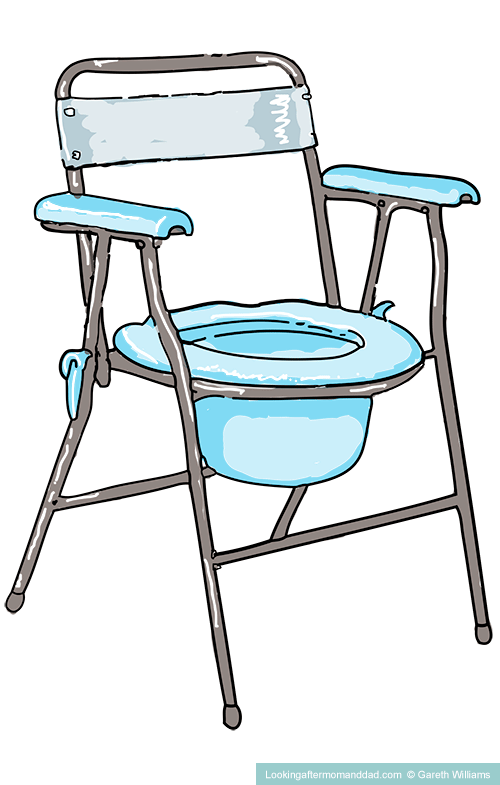
Static folding bedside commode
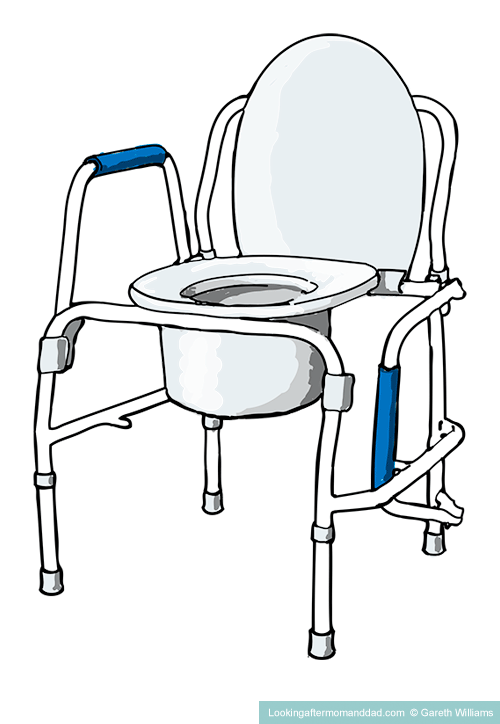
Static drop arm bedside commode
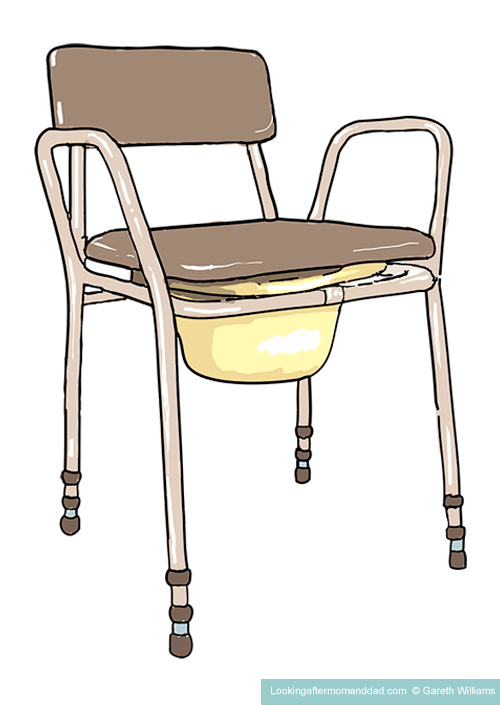
Static stacking bedside commode
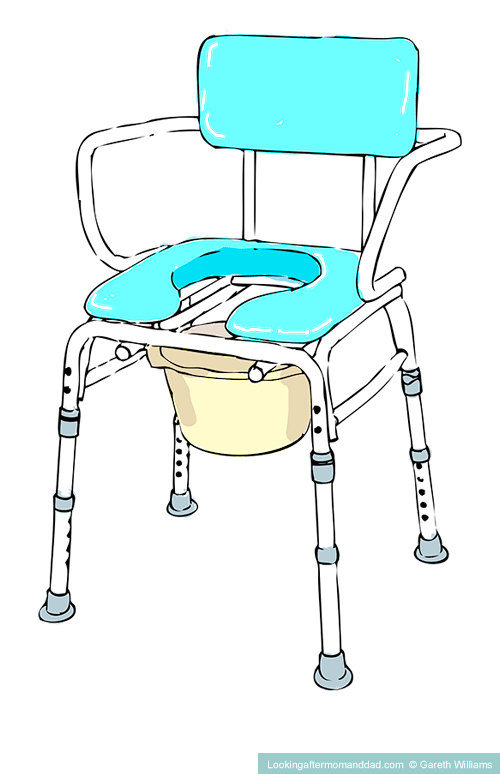
Static shower bedside commode
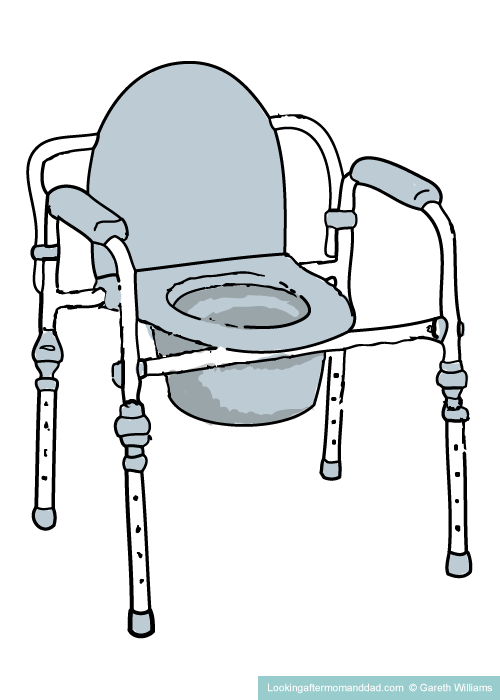
3 in 1 bedside commode
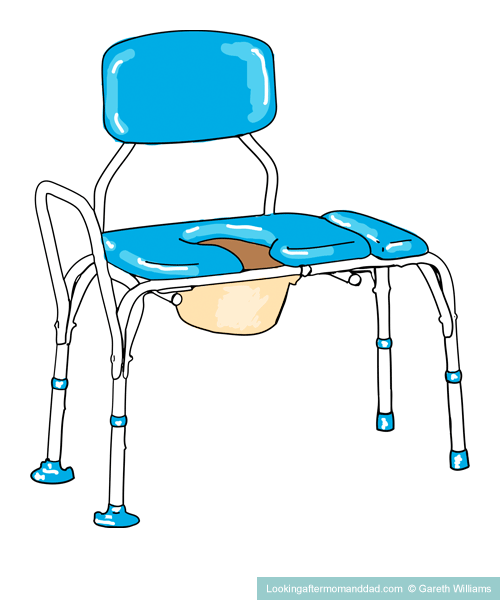
Transfer bench bedside commode
Rolling bedside commodes (with wheels)
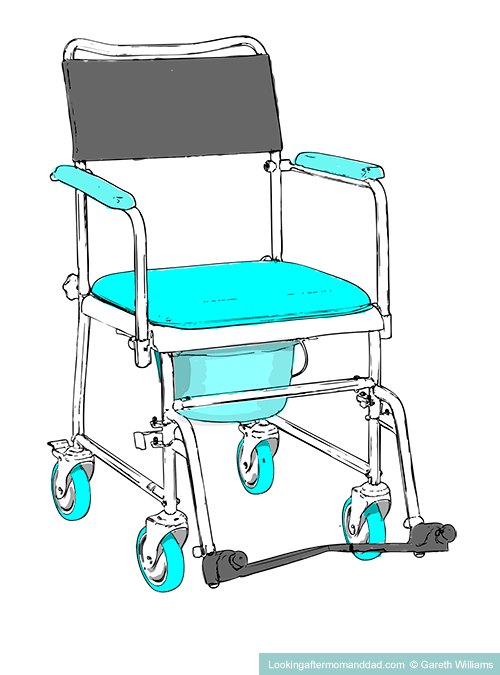
Attendant transport bedside commode
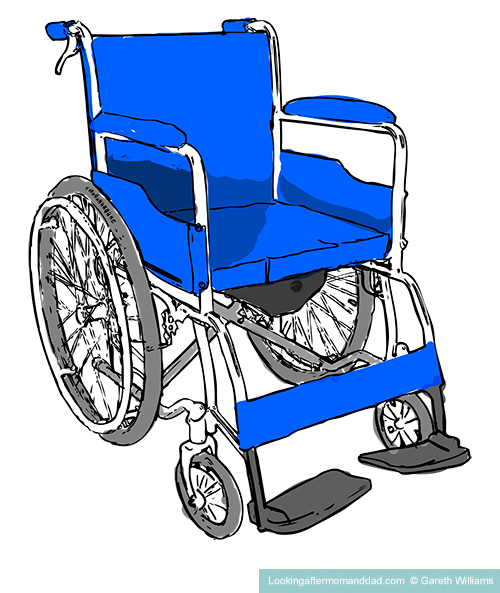
Self-propelling transport commode
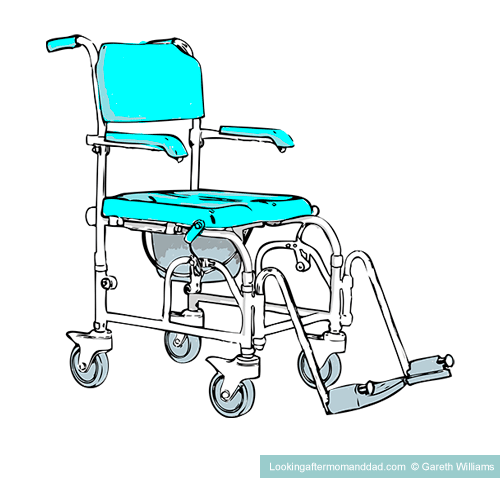
Attendant shower transport bedside commode
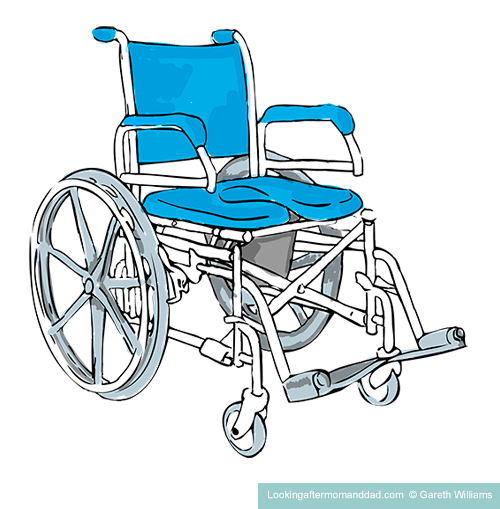
Self-propelling shower transport bedside commode
Static bedside commodes
- Folding bedside commodes – these fold out like a regular chair, with the pail/bucket simply inserted under the seat, have the lowest weight capacities, and are also easily folded and hidden away
- Stacking bedside commodes – these are standard bedside commodes which are stacked rather than folded
- Shower bedside commodes – these are a bedside commode which is also a shower chair, and is fully waterproofed
- 3 in 1 bedside commodes – these are bedside commodes which can be used as a commode, as a toilet safety frame, and as a raised toilet seats
- Drop arm bedside commodes – these are models of bedside commode which have armrests which can be either raised or lowered to provide access from the side, and are commonly used by wheelchair users – they are also very useful if a caregiver needs to gain access from the side
- Transfer bedside commodes – these are a commode and a transfer bench – you may need one if you are bedridden
The dimensions of an average, or standard sized static bedside commode, are approximately –
Seat size: 13″ wide x 14″ deep
Seat opening: 8″ wide x 10″ deep
Adjustable seat height: 17″- 23″
Width between the armrests: 18″
Overall width: 20″
Base Dimensions: 20″ wide x 20″ deep
The static bedside commodes have weight capacities which vary from 220 lb all the way up to 1500 lb – if you wish to check a bedside weight capacity, or to find models with a certain weight capacity, you can consult my article, “Bedside Commode Weight Capacity: A Guide With Over 140 Examples and Illustrations”, which lists over 140 examples, across all types.
The bedside commodes for larger individuals are referred to as bariatric, or heavy duty, bedside commodes. This is really just a term, and there are examples of bariatric commodes of almost the all the types I have so far listed, except for the lightweight and stacking bedside commodes.
To learn more about the different types of bedside commodes, and which may be the appropriate type for your situation, you take a look at my article, “Bedside Commodes: How To Make The Right Choice ?”.
If you want to know more about the standard bedside 3- in 1 bedside commode, I have a number of articles about them –
“What Is A 3-in-1 Commode ? And What Is It Used For ?”
“Drop Arm Commode vs 3 In 1 Commode: There’s At Least One Big Difference”
“Bedside Commode vs 3 In 1 ? How to Make The Best Choice !”
To learn more about bariatric commodes, I also have a number of articles with very specific information –
“How Wide Is A Bariatric Commode ?”
“Do Bedside Commodes Come In Different Sizes ?”
Rolling bedside commodes
It’s now time to take a look at the different types of bedside commodes with wheels.
The 4 types of rolling commodes –
- Attendant transport commodes – these can be used as a transport chair (propelled by another person who is pushing the commode), and as a bedside commode
- Self-propelling transport commodes – these can be used as a self-propelled transport chair, and as a bedside commode
- attendant shower chair transport commodes – these commodes are a transport chair (pushed by another person), a shower chair and a bedside commode
- self-propelling shower chair transport commodes – these can be used as a self-propelled transport chair, shower chair, and as a bedside commode
To learn more about the types of rolling commodes, you can take a look at my article “What Is A Rolling Commode ?”
What is a bariatric commode ?
As I said earlier, bedside commodes with a greater weight capacity are called bariatric, or heavy duty, commodes.
There is no declared weight capacity at which a bedside commode is designated as a bariatric commode, but it typically seems to be commodes with weight capacities somewhere between 300 lb to 400 lb, and higher.
There are bariatric versions of all the following types of bedside commode –
- bariatric 3-in-1 bedside commodes
- bariatric drop arm bedside commodes
- bariatric transfer bench commodes
- bariatric transport commodes (nothing over 350 lb weight capacity)
- bariatric shower chair transport commodes
Of the models without wheels, most will look just like the standard model of 3-in-one or drop arm commode models, but may be a bit wider, and will be made out of steel rather than aluminum alloy to support the extra weight.
There are, though, specific bariatric models which look rather different from the standard bedside commodes, and which instead of having an oval, or circular, seat which lifts up, and down, to reveal the bucket, have a fixed bench like seat which goes across the whole width of the frame.
Such models, typically, are for supporting around 500 lb or more.
These larger bariatric commodes will be pre-assembled, without folding joints, so that the commodes can support a larger weight.
If you would like to select a bariatric commode by weight, I have an article with a list of over 60 bariatric commodes, organized by weight capacity, and cataloged with their name, model number and manufacturer. You can check that article “Bariatric Bedside Commode Weight Limits: A Guide With 60 Examples And Illustrations”
Bariatric commodes with full width seats

Extra tall bedside commodes
The standard bedside commode has, at it’s widest, a seat height range of 16″ – 23″ from the floor.
But there is one really tall bedside commode, with a maximum seat height of a towering 28″ !
And that is the –
TFI Healthcare Extra tall wide commode with elongated seat
Model No: 3244
Weight capacity: 650 lb
Elongated seat size: 14 3/4″ wide x 19″ deep
Width between the armrests: 24″
Overall width: 28″
Seat height: 19″ – 28″
The “TFI Healthcare Extra tall wide commode with elongated seat” has –
- a seat which 9″ deeper than on a standard 3-in-1 commode
- the frame is 8″ wider
- the seat height maximum of 28″, is 5″ higher than the max height of a standard 3-in-1 commode
This is currently the tallest bedside commode available.
Bedside commode features
There are a number of features, or elements, which may vary across all the different bedside commodes.
Here is a list of the those features
Drop arms
- these can be on either side of the commode
- some drop arms lift and others drop down
Seat types
- Elongated – for greater access for personal hygiene
- Extra wide
- Elongated and extra wide
- Full frame width seats
- Open front – easy access for personal hygiene
- Seat inserts front and back
- Padded
- hard seats
- Lift seats – mechanized seats which lift the user
Frame types
- Aluminum
- Steel
- PVC
- Wood – this is restricted to armchair type bedside commodes – if you wish to learn about this type of commode, I have written another article which is dedicated to that and lists most of the models there are on the market today – “14 Perfectly Discreet Commode Chairs: No One Will Ever Know !”.
Wheel types
- 3″ casters
- 5″ casters
- 8″ casters
- wheelchair wheels
Adjustable leg height
- most models have a range of 3 – 5″ extra height
- the pvc models do not typically have adjustable height legs
Well known brands of bedside commodes
This next list is one showing established brands of bedside commodes (bedside commodes without wheels) –
- Big John
- Carex
- DMI
- Drive
- Gendron
- Guardian
- Homecraft
- Invacare
- Lumex
- McKesson
- Medline
- Nova
- Performance Health
- Probasics
- TFI Healthcare
- Tuffcare
Here are some of the established brands of both attendant and self propelling transport commodes and shower chair transport commodes –
- ActiveAid
- Arjo
- Drive
- Healthline Ezee Life
- Invacare
- Lumex
- Medline
- Performance Health
- Probasics
- TFI Healthcare
- Tuffcare
Where to buy bedside commodes ?
Bedside commodes can be bought at Walmart, Amazon, Walgreens, Home Depot, Target, Lowes, and at specialist medical suppliers like Rehabmart.com and American Discount Home Medical Equipment.
To buy a refurbished bedside commode, you have medical equipment refurbishment outlets all across the US run by non-profits and AT programs. More information on these below.
Amazon can be very difficult to use, as the sellers put in so many words into the titles of the commodes that the searches end up mixing everything together. You need to include the manufacturer’s product number
My personal favorite, of all, is American Discount Home Medical – https://home-med-equip.com.
You’ll find a good range of bariatric commodes from established brands.
All the specifications for every model, the manufacturers’ information, and the model numbers are easy to find for the customer. It’s a very good and easy user experience.
Once you have sorted out which bedside commode you wish to buy, you may find these articles of help –
“Where To Buy A Bedside Commode ?”
“Where To Buy A Bariatric Commode ?”
“Where To Buy Shower Commodes ?”
“Does Walmart Carry Bedside Commodes ?”
Who has the widest range of bedside commodes ?
Walmart and Amazon appear to have the widest range of bedside commodes with all types on offer, and many of the most popular brands.
Walmart and Amazon have a lot of commodes from lesser known brands, but I do tend to stay clear of those.
Home Depot has far fewer models, but they are all from well known brands.
Walgreens has a small range of static bedside commodes, as well as a small range of shower commodes, all from well known brands.
Lowes and Target carry a very few models each, from good brands, but there is little choice, and they are the most standard models.
The websites Rehabmart.com and American Discount Medical Equipment (https://home-med-equip.com) are specialists medical equipment suppliers. Both have a wide range of bedside commodes, and a lot of specialist commodes as well.
How much does a bedside commode cost ?
Bedside commodes cost between approximately $40.00 and $3300.00
A standard portable bed side commode, typically costs between $70.00 – $100.00
The average price, by type, is –
Static bedside fixed arm commodes cost between $40.00 to $815.00
Static drop arm bedside commodes cost between $72.00 to $1364.00
Static shower chair bedside commodes cost between $120 to $200.00
Transport bedside commodes cost between $192.00 to $449.00
Shower Transport bedside commodes cost between $120.00 to $3300.00
Transfer bench bedside commodes cost between $117.00 to $1845.00
If you would like to see a listing of current bedside commode prices, I have just that in an article, along with their weight capacity, model number and price – “How Much Does A Bedside Commode Cost ? A Guide With Over 160 Examples By Category”
Will Medicare Part B or a Medicare Advantage plan cover a bedside commode ?
If the bedside commode you are buying, for someone who is enrolled in Medicare Part B, or a Medicare Advantage plan, maybe you can get it covered by Medicare.
If the bedside commode is prescribed by a Medicare-enrolled physician, as “medically necessary”, and purchased from a Medicare-approved supplier, it will be covered for 80% of the Medicare-approved price of the commode.
If you want to find out more about coverage for bedside commodes with Medicare, I have an article about the whole process, which you can read “Does Medicare Cover Bedside Commodes ?” here.
In the same article which I linked to above, there is also an explanation of how a person with Medicaid coverage may also qualify for a bedside commode, through different state programs. These programs do vary by state, and some states may not have them, but the information on how to find is in the second half of this article here.
The article show you where you can check to see the programs which are available in your state, and who to contact to find out if you qualify, etc.
When is a bedside commode covered by Medicare ?
Typically, for a bedside commode to be covered by Medicare Part B, as durable medical equipment for use in the home, you must –
- be enrolled in Medicare Part B
- have a signed prescription from a Medicare-enrolled physician certifying that the bedside commode is “medically necessary”
- acquire the equipment from a Medicare-approved equipment supplier
In this case, Medicare Part B typically covers 80% of the Medicare-approved price of a bedside commode.
This is the Medicare text –
“Commode chairs
Part B (Medical Insurance) covers commode chairs as durable medical equipment(DME) when ordered by a doctor for use in your home if you can’t use a regular toilet.“
The original text is here – Medicare.gov.
Your Medicare-enrolled physician must show that it is considered that you are medically unable to use the toilet, or get to the toilet without assistance.
Is it worth using Medicare to pay for a bedside commode –
Now, paying your deductible to get 80% off the price of a $200.00 bedside commode is going to seem a bit crazy, as it will likely be more than the cost of a simple bedside commode.
Although, if you have already paid your deductible for the year in question, you will get a $200 commode for $40, which is more interesting.
Of course, if you are buying a $1000.00 bedside commode, it will be worth doing it, whether you have paid your deductible already, or not.
If you have a Medicare Advantage plan, or Part C as it is also known, you are entitled to the same coverage as medicare Part B, although the coinsurance rate may not be the same, as you pay with Medicare Part B.
As I noted earlier, if you want more details, you can take a look at my article, “Does Medicare Cover Bedside Commodes ?”.
Where do you buy a bedside commode with Medicare Part B ?
You can use this link to find a local Medicare-approved DME supplier on Medicare.gov.
How can veterans get covered for a bedside commode ?
For veterans, the Department of Veterans’ Affairs has different grants, programs, forms of financial assistance and pensions to help cover the cost of equipment such as bedside commodes.
You can contact your local VA Medical Centers, Clinics and offices here.
Where can you buy a refurbished bedside commode ?
Charity thrift stores
To buy a “gently used” bedside commode which has been refurbished, there are quite a few options, including thrift charity stores.
Some of the larger charity thrift store organizations are –
- Goodwill
- Salvation Army
- DAV Thrift stores – proceeds to providing resources for American veterans and their families
- Desert Industries
- Habitat for Humanity
- Society of St Vincent de Paul
- Catholic Charities
- Out of the closet
- Mission thrift stores
- Downtown Rescue Mission ( Alabama)
- United Methodist Thrift stores
- Rescue mission thrift stores ( GRM”s Gospel Rescue Missions) faith-based organizations
working primarily with the homeless - Boomerangs Thrift Stores – run by AIDS Action
- Assistance league – the local chapters are overseen by the National Assistance league all over the US and has lots of thrift stores.
- Arc is another charity which runs thrift shops – intellectual and developmental disabilities
Probably the best known are –
Goodwill
There are local Goodwill stores all across the country.
To find your local store, visit their website here – https://www.goodwill.org/locator/
Salvation Army
The Salvation Army has a huge network of stores across the country.
To find your local store, visit their website here – https://satruck.org/
Other thrift store will also typically sell gently used bedside commodes, but they are not charitable organizations, and are for-profit businesses, and I chose to promote charities here.
Nonprofit refurbishing
Many nonprofit organizations work across the US, in their local communities, refurbishing used medical equipment.
To find out about the different refurbishing centers and nonprofits in your area, you can either use the internet or a great idea is to contact your local Area Agency on Aging.
Area Agency On Aging
Area Agencies on Aging are deeply involved with local community groups, and work to help caregivers and the elderly to get the services they require.
If you don’t know where your Area Agency on Aging is, you can use their locator tool – click here to do so.
Assistive Technology Programs for bedside commodes
Your State Assistive Technology Program was established to increase access AT device and equipment for people with disabilities and the elderly.
These AT programs are frequently are partnered with nonprofit organizations who work to recycle and refurbish devices and equipment.
Assistive Technology Devices are devices which help an individual complete a task, or action, that they are otherwise unable to do – it covers most durable medical equipment.
Not all states have a very well established program, but it is well worth finding out what your state offers, as some are very developed and provide a lot of help to those in need.
The State AT programs all have a website which –
- coordinate all their services
- listing of events and equipment demonstrations
- coordinate their medical equipment loan closets
- maintain their outreach programs
- take registrations of those in need of assistance and equipment
You can contact the website to find out where your local refurbishing centers are, to buy cheap equipment or even get it for free if you are in financial difficulty.
A few AT Programs have also got an “Online AT Exchange”, where once registered, you can exchange, buy, sell or donate equipment.
You do have to be a state resident of the state to join to get any of these services.
I have listed all the state AT Programs, along with links to their websites, in another article about donating bedside commodes. You just click on your state, and that will take you to the individual websites. You can find that here.
When should you start using a bedside commode ?
I would consider that it is time to use a bedside commode when –
- you are very fragile, and have problems moving quickly enough to get to the toilet on time
- you are bedridden
- you have to use a wheelchair to move around your home
- you are going to the toilet frequently at night, and you feel a toilet by the bed is a safer option
- you are elderly, and you have a tough time sitting down on, and standing up from, your toilet
- you cannot get to the bathroom without assistance, and need a toilet in another room
- if you have had surgery and cannot get to the toilet without assistance, or fast enough on your own, and you need a toilet next to you
For individuals who are unable to stand, a commode can be placed right up against the bed, which they can then slide over onto, without standing. In such a case, the person would use a transfer commode, as used by many wheelchair users.
For a bedridden individual who is unable to slide themselves over onto the commode, or to stand, a caregiver would use a patient lift to place them onto the bedside commode.
A commode may also be placed by the bed, or in a living area, because the user is not able to get to the toilet quickly enough, and it helps to avoid accidents.
For many fragile elderly adults, it is a very good idea to have a bedside commode right next to the bed, to avoid falls at night due to frequent toilet trips in a drowsy and stiff state.
My mom can be incredibly stiff and drowsy when she gets up to go to the bathroom at night, which can result in her being somewhat unsteady.
If you feel you want to find out more, you can take a look at this article – “When Should You Start Using A Commode ?”.
Benefits of bedside commodes
A bedside commode can be of great benefit for a person with reduced mobility, what ever the reason for that may be.
The benefits of a bedside commode can be –
- makes sitting and standing simpler and safer
- builds confidence once the user feels safer
- a person can gain in independence, freedom and control
- it can also mean increased privacy and sense of dignity for the user if they don’t need help
- easy and quick access, as they can be placed them anywhere
- in certain situations, it may be easier for wheelchair users than a toilet
- more comfortable to use than a bed pan
- you can adjust the seat height to reduce bending
- you can purchase models in all sizes, including for larger individuals
- prices for bedside commodes start as low as $40.00
- using a bedside commode can mean that there is no need for home renovation
- most bedside commodes are extremely portable
- for those who need help with walking, there are transport bedside commodes
- models like the 3-in-1 commode have multiple uses
- certain models can also be used over an existing toilet
To read more about the benefits of bedside commodes for our elderly loved ones – “19 Benefits Of Bedside Commodes: Making Life Easier For Seniors”
How often should a bedside commode be cleaned ?
A bedside commode should be cleaned after each use, especially if you are not using a commode liner.
If you don’t clean the commode, the bacteria will become airborne, spread, and the person in the room will be breathing this in, as well as it being unpleasant to be surrounded by the odors of the commode, it is also not healthy.
The odors will spread throughout the room and get absorbed into all soft furnishings and unsealed surfaces
Typically, the users of bedside commodes are elderly, and their skin is thin and prone to tearing, which, if it comes into contact with surfaces covered in bacteria, will more easily become infected.
As such, you have to keep the seat, armrests and bucket immaculate, and free of bacteria
There is quite a lot more to this, and you can read about that here in my article “How Often Should A Bedside Commode Be Cleaned ?”.
How to clean a bedside commode ?
When you clean a bedside commode, you also have to use the right products so that you kill all the bacteria, it has to be done regularly, and so as not to spread bacteria around the home, you need to make sure that you wear some kind of protective clothing, as well as disposable gloves.
Certain parts need to be soaked in disinfectant, some have to be disassembled, and others checked for any signs of corrosion and cracking.
If you want to find out about how to clean any kind of bedside commode, I have an article about that – “The Best Way To Clean A bedside Commode ?”.
How to clean a commode bucket ?
If you are using a commode pail/bucket without commode liners, you are going to have to pay particular attention to the cleaning of it.
It’s not a fun job, but there are a number of tips which will make it easier, bearable and more effective.
The main tip is to have a number of buckets, so that you can rotate them, and while you are cleaning them, you can soak them in disinfectant for a number of hours. This is because the plastic absorbs odors and bacteria, so if you soak them in bleach you can kill the bacteria causing these smells. If you only have one bucket/pail, this is hard to do.
If you want to know more about other cleaning tips, I have an article about just that, which is full of the stuff that I have picked up over the years – “Great Tips On How To Clean A Commode Bucket: The Products, The Method And Keeping It Smelling Sweet !”.
How often should a bedside commode be emptied ?
The bedside commode pail/bucket should be emptied immediately after each use.
If you don’t empty it, the odors will start to spread everywhere, and it all becomes rather unhealthy and unpleasant for the person using the room. And believe me, the odors won’t just stop in the room, they will spread throughout the home.
Even if you are using disposable commodes liners, the same applies, you need to remove the commode liner straight away, and only use them once.
To learn more, you can read my article about this –“Empty And Clean It Properly Every Time ! Don’t Let Stuff Sit In A Bedside Commode”.
Disposable commode liners
For individuals who don’t want to have to deal with emptying a commode bucket down the toilet, there are disposable commode liners.
Disposable commode liners are plastic liners, like bags, which you place down into the commode bucket, covering the insides and up over the rim.
Typically, an absorbent pad is placed at the bottom of the liner, inside the bucket, to absorb all the liquids.
Once the user has finished on the commode, the liner can be removed, tied up, and disposed of in the landfill trash outside.
I have an article where you can find out more about the use of disposable liners, where to buy them in bulk, the different popular brands, and, if you are so inclined, how to make your own. That article is available here – “How To Dispose Of Commode Liners ?”.
Bedside commode odor control
To keep odors to a minimum, you can use disposable commode liners and throw them out immediately.
I’ve already mentioned, that you need to empty the commode every time it is used, and not to leave it any longer than you have to before emptying it.
For those of you who don’t want to use disposable liners, it is a good idea to buy one or two extra pails/buckets, and after each use, empty, rinse and soak the pail/bucket, in disinfectant for several hours.
Any wooden furniture near the commode really should be sealed, so that it won’t absorb smells – this needs a varnish.
Soft fabrics also absorb smells, so you need to wash curtains and bed covers more frequently, or for curtains use Lysol fabric sprays to kill the bacteria causing the smells.
The area around the commode should be regularly cleaned and disinfected, and on the floor under the commode, in case there are spillages, which there inevitably will be, have some kind of waterproof mat.
For more information on floor protection, you can take a quick look at my article on “Floor Protection For Bedside Commodes”, it is simply a list of the different options available.
If you have a spillage, and you have no mat, you can use enzymatic cleaners, sold in pet stores. These are great at cleaning up, as they are formulated to clean up messes from cats and dogs on carpets.
If opening the window is not enough to get rid of odors, or is simply not an option, if you have an outside wall in the room, you may want to consider installing an extractor fan, as close to the commode as possible.
To get lots more ideas and tips like these, you can take a look at this article on the subject, “Bedside Commode Odor Control: How To Keep It Smelling Sweet ?”
How to keep a commode from tipping ?
There are really only a few solutions that will stop a bedside commode from tipping –
1) You can place the bedside commode into a confined space which blocks any tipping –
- in the corner of the room against two walls and a piece of furniture against one side as well
- between the bed and the corner of the room
- you can purchase a specific commode chair – the Derby Corner Commode Chair – which is designed in such a way that the user’s back is facing the corner, and the commode cannot tip
- make sure to remove any clutter and obstacles from around the bedside commode to avoid any falls
2) For me, the best way to avoid tipping, is to make sure that your loved one knows how to sit down on a commode with a walker, to help them maintain their balance.
To find out more, you can take a look at my article, “How To Keep A Bedside Commode From Tipping Over ?”.
Can you use a bedside commode over a toilet ?
A standard 3-in-1 bedside commode can be used over a toilet as –
- a toilet safety frame
- a raised toilet seat
To use a 3-in-1 commode over a toilet –
- you remove the pail from under the seat
- adjust the height of the legs so that the seat is at the right level
- lift the seat and lid of your toilet
- place your commode over your toilet
If you need more information about using a bedside commode over a toilet, take a look at this article – “Can A Bedside Commode Be Used Over A Toilet ?”.
It includes a complete list of bedside commodes which can be used over the toilet, as well as the maximum heights of the different models.
If you need to use a splash guard with your bedside over the toilet, and you’re not sure what it is and how it works, you can find out about them in my two articles on splash guards for bedside commodes –
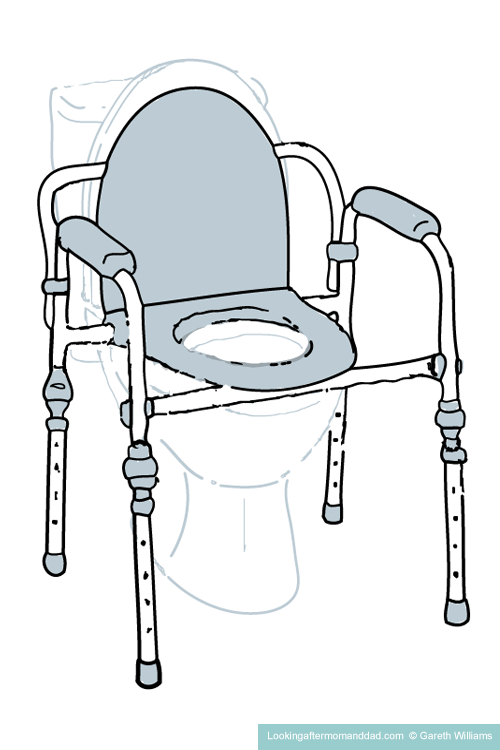
bedside commode installed over a toilet
I’m Gareth, the author and owner of Looking After Mom and Dad.com
I have been a caregiver for over 10 yrs and share all my tips here.

